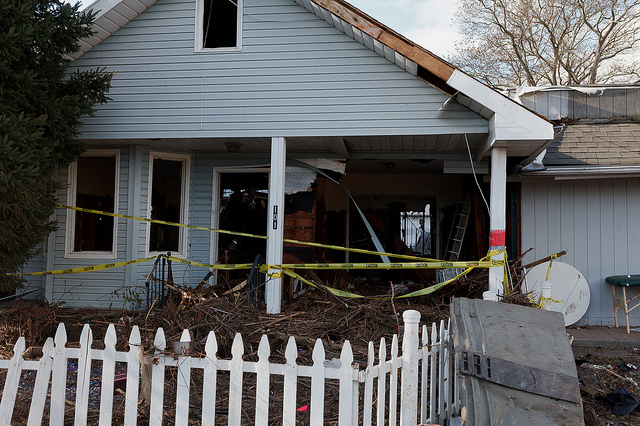That’s some view, right? Imagine waking up to that every morning, heading out to the beach during the summer with a picnic and a book. It’s a subset of the American dream: a place on the beach that you retire to, frittering away hours upon end.
Sometimes, though, things like this happen:
That’s a house in the New Dorp Beach section of Staten Island, an area ravaged by Hurricane Sandy.
Storm damage in coastal areas is not new. But the increased severity of storms seems to be, as is the increased urgency behind a long-standing question: Should the government facilitate rebuilding in areas that are prone to natural disaster?
From The New York Times:
Across the nation, tens of billions of tax dollars have been spent on subsidizing coastal reconstruction in the aftermath of storms, usually with little consideration of whether it actually makes sense to keep rebuilding in disaster-prone areas. If history is any guide, a large fraction of the federal money allotted to New York, New Jersey and other states recovering from Hurricane Sandy — an amount that could exceed $30 billion — will be used the same way.
Tax money will go toward putting things back as they were, essentially duplicating the vulnerability that existed before the hurricane.
“We’re Americans, damn it,” said Robert S. Young, a North Carolina geologist who has studied the way communities like Dauphin Island [off the coast of Alabama] respond to storms. “Retreat is a dirty word.”
There are other dirty words that might apply here. For example: Are you f–king kidding me? According to the Times, some $80 million (adjusted for inflation) has been spent by the federal government to repair Dauphin Island since 1979 — excluding federally subsidized flood insurance. The article outlines the various ways in which Dauphin Island has been preserved and improved at taxpayer expense, with one generation of repairs washed out to sea during the next big storm.
“We simply can’t go on subsidizing enormous numbers of people to live in areas that are prone to huge natural disasters,” said Eli Lehrer, the president of the conservative R Street Institute …
This argument might be gaining some traction. Earlier this year, Congress passed changes to the federal flood insurance program that are supposed to raise historically low premiums and reduce homeowner incentives for rebuilding in the most hazardous areas.
(That increase in flood insurance was not without debate.)
What makes this debate more pressing is not the expanding federal budget deficit. It’s the expanding number of areas likely to be affected by weather disasters in an era of higher sea levels and bigger storms.
Perhaps the new American Dream should be a bunker, deep within a mountain, heavily stocked with cans of food and reserves of water, where one can calmly wait out the end times. As with the beach: bring a book.





